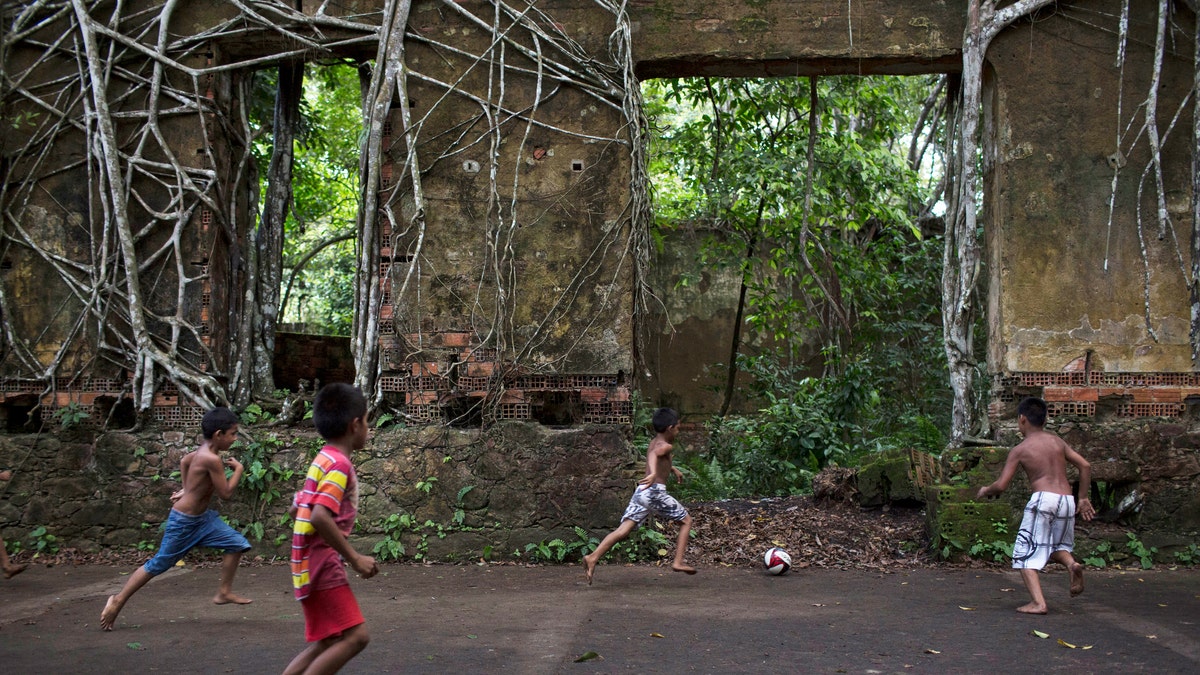
In this May 21, 2014 photo, Children play soccer in the ruins of Paricatuba, near Manaus, Brazil. (ap)
PARICATUBA, Brazil (AP) – If Hollywood were to set a psychological thriller in the Amazon rainforest, the haunting Paricatuba Ruins would be the perfect backdrop.
Massive root structures poke through the foundations of the once-stately neo-classical edifice, across the Rio Negro from the jungle metropolis of Manaus, one of the cities set to host World Cup matches.
Tourists arriving for soccer's premier event are unlikely to stumble upon the ruins. There is virtually no signage pointing toward the site. It can be reached only by boat or by car for those who cross a new bridge spanning the Rio Negro and endure an hour-long ride over bumpy dirt roads.
Those living near Paricatuba, however, hope the jungle enshrouded villa will attract the more adventurous travelers among the 52,000 or so foreigners expected to descend Manaus for the matches featuring the U.S., England, Italy, Switzerland, Croatia, Cameroon, Portugal and Honduras.
Tree trunks braid around crumbling bricks and shards of fancy tile work. Pythons and iguanas make their homes in the carpet of waist-high brush.
It was built in 1898 at the height of the region's rubber boom, which briefly transformed Manaus into one of the richest cities in the world. The sprawling villa was initially intended to house the Italian immigrants who arrived to work in the rubber trade.
The building's decline over the next century mirrored that of Manaus, which after the rubber boom went bust, slipped into a long period of decadence and decay.
After the Italian migration dried up, the villa housed an art school run by French priests. Then it became a penitentiary. Then a leper colony, before simply being abandoned to the tropical elements.
The roof caved in, and the vegetation took over. During mango season, the ground becomes slick with the fruit's rotting pulp. The thud of falling watermelon-sized jackfruits punctuates the eerie silence of the place.
Today, it is open for all who wish to visit. There is no charge to roam the ruins. The cost of a boat or car ride to the spot depends upon the whim of the captain or driver.
Children of the tiny village of Paricatuba, which grew up around the villa, use the ruins as a spot for energetic games of barefoot soccer or to scare themselves silly. Teenagers come here to make out, and older people to get drunk.
Darker things, too, are said to take place inside these crumbling walls.
"It's full of ghosts and bones," said Alice Lopes da Silva, an 8-year-old girl who was among a pack of local kids leading an unofficial tour of the building.
There's the room fitted out with rusting, vine-engulfed bars that once kept prisoners in check. There's a former bathroom with spooky red streaks along one of the walls and a straw broom leaning in the corner — left there, one of the kids suggested, by a witch. There's the spot where, legend has it, lepers' bodies were burned.
If World Cup visitors do make the effort to visit the ruins, they need not worry about finding a guide. Packs of schoolchildren eagerly greet new visitors, excited by the chance to show travelers their unique playground.
"Just follow me," said 8-year-old Silva as she pulled back a rope of vines to open a path for visitors.
Follow us on twitter.com/foxnewslatino
Like us at facebook.com/foxnewslatino

